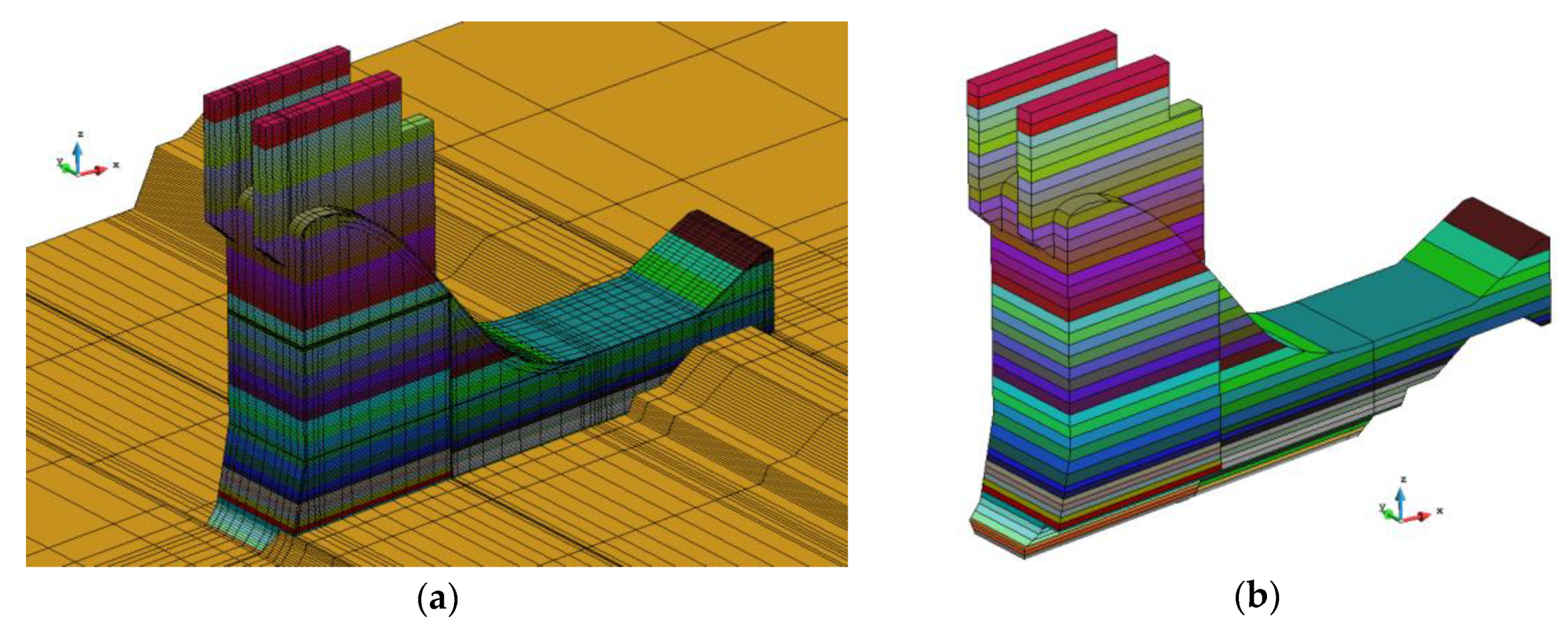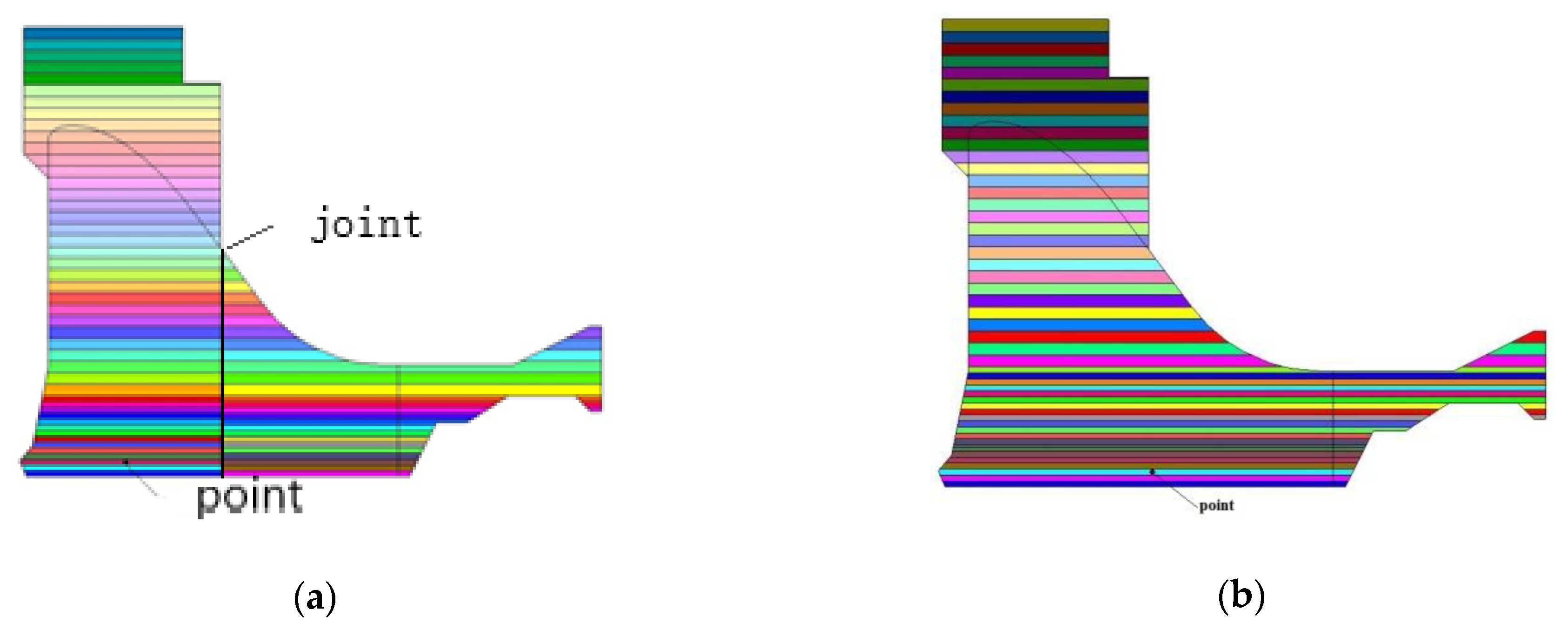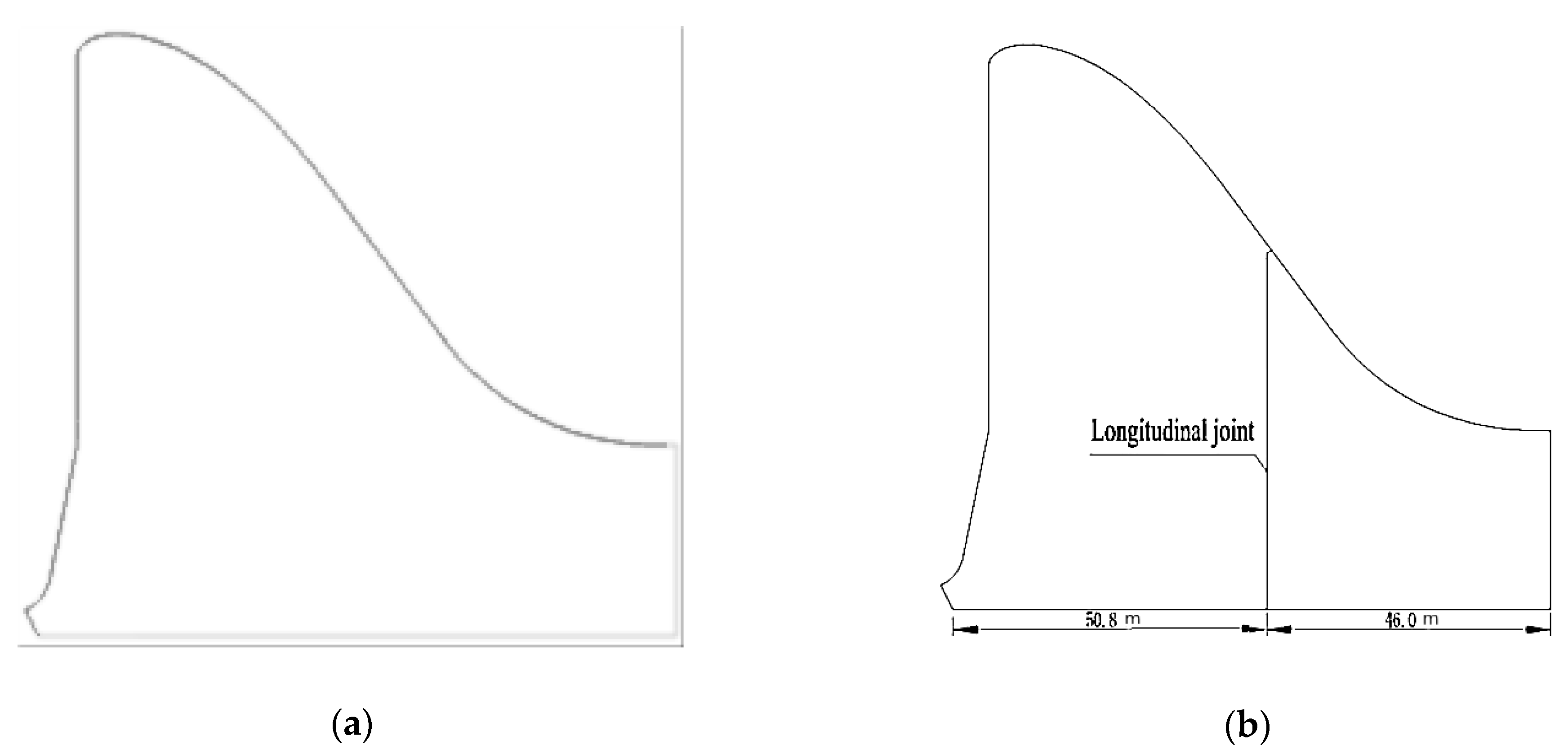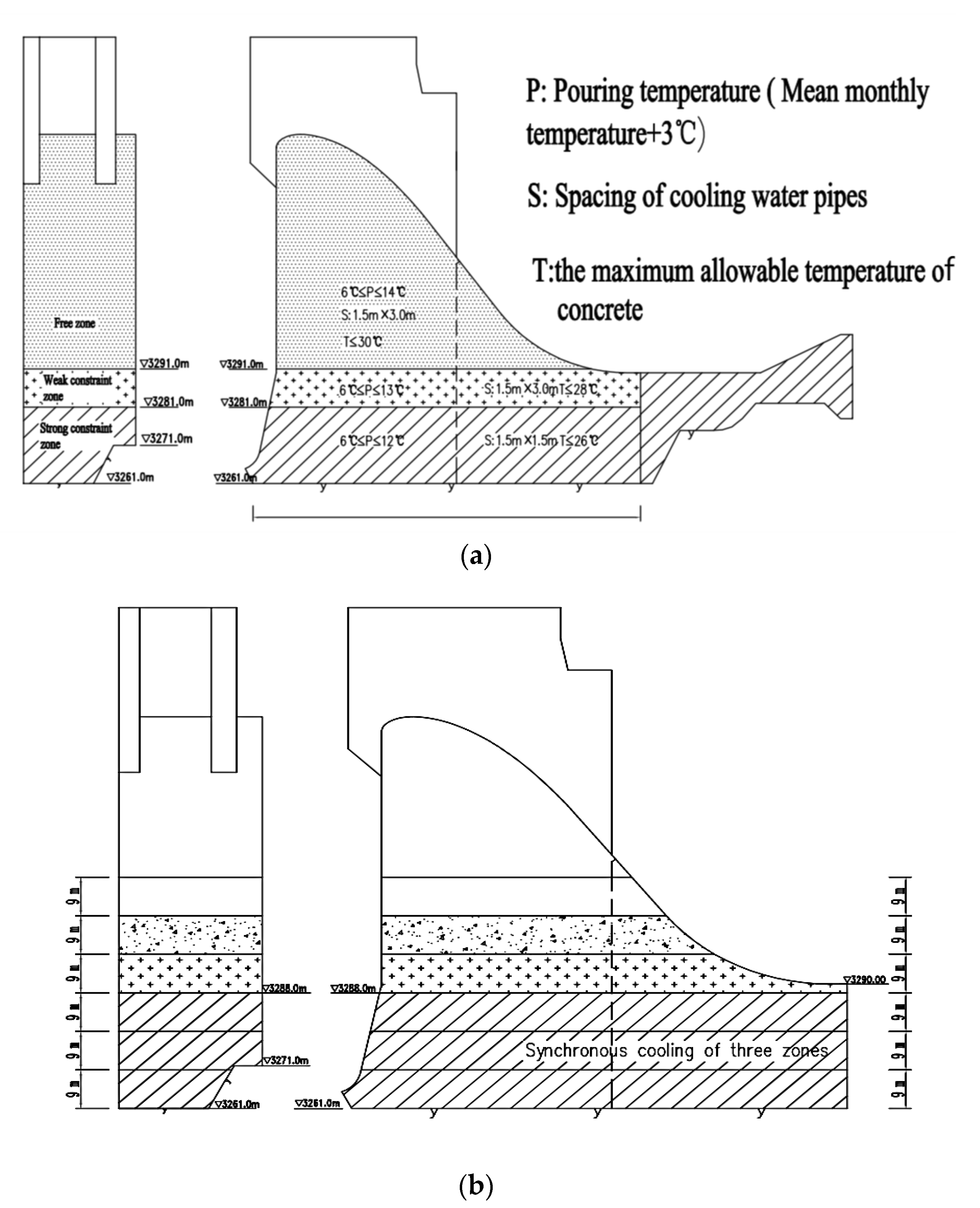Influence of Longitudinal Joint Setting and Synchronous Cooling Zone on High Altitude Region’s Dam Construction
Abstract
:1. Introduction
2. Materials and Methods
2.1. Finite Element Method of Concrete Temperature Fields
2.2. Finite Element Method of Concrete Stress Fields
2.3. Equivalent Heat Conduction Equation with Concrete Cooling Water Pipe
2.4. Construction Features of the JX Gravity Dam
2.4.1. Hydrology and Meteorology
2.4.2. Material Parameters
2.5. Numerical Calculation Model
2.5.1. Calculation Models and Boundary Conditions
2.5.2. Calculation Parameter Model
2.5.3. Feature Point and Feature Cross-Section
3. Results and Discussion
3.1. Temperature Stress without Longitudinal Joint
3.2. Temperature Stress with Longitudinal Joint
3.3. Reasonableness Analysis of Longitudinal Joint Position
3.4. Impact of Synchronous Cooling Zone on the Temperature Stress of the Dam Body
- The height of a JX Dam grouting zone is 9 m, i.e., each grouted zone is 9 m in height;
- Grouting zone: The zone where longitudinal joint grouting is to be carried out, generally one zone;
- Synchronous cooling zone: The zone where cooling is carried out simultaneously and coordinately. When the grouting zone is the first grouted zone at the bottom of the constraint zone, the synchronous cooling zone is two grout zones above the grouting zone, while the other zones are a grout zone above the grouting zone;
- Transition zone: The zone between the synchronous cooling zone and weighted cover zone, a grouting zone above the synchronous cooling zone;
- Weighted cover zone: Newly placed concrete zone, a grouting zone above the transition zone.
- 6.
- When the synchronous cooling zone’s height varies, it has a minimal impact on the maximum temperature. The maximum temperatures of the strong constraint zone are all 26.3 °C;
- 7.
- If the synchronous cooling zone is 9 m in height (each grouted zone is 9 m in height), each grouting zone is cooled via cooling water. As the temperature difference and deformation between the upper and lower ground zones do not synchronize, the foundation concrete is under more vital constraints. The maximum stress in the middle of the strong constraint zone is up to 1.58 MPa, while cracks can be easily caused;
- 8.
- If the synchronous cooling zone is 18 m in height, the two grouting zones are cooled in a coordinated manner. The constraint on foundation concrete is obviously reduced by reducing the temperature difference and synchronous deformation between the upper zone and the lower zone. The maximum stress in the middle position is 1.45 MPa. Although the growth of safety factor meets specifications (more than 1.65), the margin is small;
- 9.
- If the synchronous cooling zone’s height is increased to 27 m, the three grouting zones are cooled in a coordinated manner. As the scope of the temperature difference reduction and synchronous deformation increases, the constraint on the foundation concrete is further reduced. The maximum stress in the middle position is reduced to 1.40 MPa, while the safety factor has an apparent increase;
4. Conclusions
- Due to the particular climate conditions, it is difficult to control the temperature and crack of concrete during the construction period when building a dam in a high-altitude area. Simultaneously, dam construction technology and engineering in low-altitude areas are not suitable for dams in high-altitude areas. Therefore, it is necessary to study technical improvements.
- When there is no longitudinal joint, maximum stress occurs in the middle of the dam’s length direction. Setting the longitudinal joint in the middle of the length direction at the bottom of the dam can significantly reduce the temperature stress along the river, lower the possibility of cracking, and increase the mass concrete structure’s crack resistance.
- Furthermore, setting the synchronous cooling zone can make the upper and lower pouring layers deform synchronously, reducing the mutual restraint between the concrete layers and the temperature stress. Meanwhile, the larger the synchronous cooling zone’s height, the more favorable it is to reduce the temperature stress, but the construction schedule requirements of the project should also be considered.
Author Contributions
Funding
Institutional Review Board Statement
Informed Consent Statement
Data Availability Statement
Conflicts of Interest
References
- Lu, L.; Li, X.G. Research and Progress of Control for Mass Concrete Temperature Crack. J. Water Resour. Archit. Eng. 2012, 10, 146–150. [Google Scholar]
- Ding, B.Y.; Wang, G.B.; Huang, S.P.; Yue, Y.Z.; Hu, P. A review on causes of cracking in domestic concrete dams and preventive measures. Water Resour. Hydropower Eng. 1994, 4, 12–18. [Google Scholar]
- Atiş, C.D. Heat evolution of high-volume fly ash concrete. Cem. Concr. Res. 2002, 32, 751–756. [Google Scholar] [CrossRef]
- Zhu, B. Thermal Stresses and Temperature Control of Mass Concrete; Butterworth-Heinemann: Oxford, UK, 2013. [Google Scholar]
- Komonen, J.; Penttala, V. Influence of admixture type and concrete temperature on strength and heat of hydration of concrete. In Proceedings of the 10th International Congress on the Chemistry of Cement, Göteborg, Sweden, 2–6 June 1997; pp. 1–8. [Google Scholar]
- Konsta-Gdoutos, M.S.; Shah, S.P. Hydration and properties of novel blended cements based on cement kiln dust and blast furnace slag. Cem. Concr. Res. 2003, 33, 1269–1276. [Google Scholar] [CrossRef]
- Sioulas, B.; Sanjayan, J.G. Hydration temperatures in large high-strength concrete columns incorporating slag. Cem. Concr. Res. 2000, 30, 1791–1799. [Google Scholar] [CrossRef]
- Tank, R.C.; Carino, N.J. Rate constant functions for strength development of concrete. Mater. J. 1991, 88, 74–83. [Google Scholar]
- Wang, Z.; Liu, Y.; Zhang, G.; Hou, W. Schematic study on temperature control and crack prevention during spillway tunnel concreting period. Mater. Struct. 2015, 48, 3517–3525. [Google Scholar] [CrossRef]
- Wang, Z.; Liu, Y.; Zhang, G.; Yu, S. Sensitivity analysis of temperature control parameters and study of the simultaneous cooling zone during dam construction in high-altitude regions. Math. Probl. Eng. 2015, 2015, 528589. [Google Scholar] [CrossRef]
- Wang, Z.-H.; Zhu, Y.-M.; Yu, S.-P. Study on temperature control and crack prevention of thin-walled concrete structures during the construction period. J. Xi’an Univ. Archit. Technol. (Nat. Sci. Ed.) 2007, 6. [Google Scholar] [CrossRef]
- Wang, Z.; Liu, Y.; Yu, S. Surface thermal insulation and pipe cooling of spillways during concrete construction period. Math. Probl. Eng. 2014, 2014, 973680. [Google Scholar]
- Guo, J. Temperature Control of Mass Concrete in Diversion Channel of Tongzilin Hydropower Station. Water Power 2012, 38, 47–49. [Google Scholar] [CrossRef]
- Zhou, Z.Q. Natural Conditions and Major Construction Features of Manla Water Control Project. Water Resour. Hydropower Eng. 2000, 31, 5–7. [Google Scholar]
- Liao, C.; Mao, W. Temperature Control Construction Technology of Mass Concrete in High and Cold Regions. Sichuan Water Power 2012, 31, 6–8. [Google Scholar]
- Yang, H. Construction Technology of Mass Concrete in High-Altitude Regions. Qinghai Transp. Technol. 2011, 50–51. [Google Scholar] [CrossRef]
- Yu, X.; Li, C. The Reason of Concrete Cracking and Control Measures under Severe Environment. Qinghai Electr. Power 2011, 30, 53–55. [Google Scholar]
- Bazant, Z.P.; Murphy, W. Creep and shrinkage prediction model for analysis and design of concrete structures-model B3. Matériaux Constr. 1995, 28, 357–365. [Google Scholar]
- De Schutter, G. Finite element simulation of thermal cracking in massive hardening concrete elements using degree of hydration based material laws. Comput. Struct. 2002, 80, 2035–2042. [Google Scholar] [CrossRef]
- Jin, F.; Chen, Z.; Wang, J.; Yang, J. Practical procedure for predicting non-uniform temperature on the exposed face of arch dams. Appl. Therm. Eng. 2010, 30, 2146–2156. [Google Scholar] [CrossRef]
- Léger, P.; Côté, P.; Tinawi, R. Finite element analysis of concrete swelling due to alkali-aggregate reactions in dams. Comput. Struct. 1996, 60, 601–611. [Google Scholar] [CrossRef]
- Noorzaei, J.; Bayagoob, K.; Abdulrazeg, A.; Jaafar, M.; Mohammed, T. Three dimensional nonlinear temperature and structural analysis of roller compacted concrete dam. Comput. Modeling Eng. Sci. (CMES) 2009, 47, 43. [Google Scholar]
- Schindler, A.K. Concrete Hydration, Temperature Development, and Setting at Early-Ages. Ph.D. Dissertation, University of Texas at Austin, Austin, TX, USA, 2002. [Google Scholar]











| Design Indexes | Main Parameters for Mix | ||||||
|---|---|---|---|---|---|---|---|
| Sand Ratio (%) | Water-Binder Ratio | Water Consumption (kg/m3) | FA Admixture Amount (%) | Water Reducer (%) | Air Entraining Agent (/10,000) | Volume-Weight (kg/m3) | |
| Dam concrete C9020W6F100 | 24 | 0.55 | 85 | 35 | 0.8 | 2.0 | 2410 |
| Name of Index | Unit | Dam Concrete |
|---|---|---|
| Thermal diffusivity | 10−3 m2/h | 2.82 |
| Heat conductivity coefficient | kJ/(m·h·°C) | 6.12 |
| Specific heat | kJ/(kg·°C) | 0.90 |
| Linear expansion coefficient | 10−6/°C | 9.00 |
| Volume-weight | kN/m3 | 24.10 |
| Poisson’s ratio | / | 0.17 |
| Age (Day) | Autogenous Volume Deformation (10−6) | Age (Day) | Autogenous Volume Deformation (10−6) | Age (Day) | Autogenous Volume Deformation (10−6) |
|---|---|---|---|---|---|
| 0 | 0.0 | 11 | 3.3 | 80 | −13.5 |
| 1 | 0.0 | 14 | 1.1 | 93 | −14.6 |
| 2 | 1.1 | 16 | 0.5 | 100 | −14.5 |
| 3 | 0.9 | 18 | −1.0 | 110 | −14.9 |
| 4 | 2.4 | 28 | −5.4 | 120 | −14.9 |
| 5 | 4.1 | 44 | −9.1 | 130 | −14.8 |
| 7 | 5.4 | 56 | −10.2 | 140 | −14.5 |
| 8 | 3.5 | 63 | −11.6 | 150 | −14.1 |
| 10 | 3.3 | 70 | −12.8 |
| Longitudinal Joint | Maximum Temperature in Strong Constraint Zone (°C) | Maximum Tensile Stress in Strong Constraint Zone | ||
|---|---|---|---|---|
| σx (MPa) | Elevation (m) | Safety Factor k | ||
| Yes | 26.3 | 1.45 | 3263 | 1.74 |
| No | 26.3 | 1.71 | 3263 | 1.48 |
| Working Conditions | Height of Synchronous Cooling Zone (m) | Maximum Temperature of Strong Constraint Zone (°C) | The Maximum Tensile Stress of Strong Constraint Zone | ||
|---|---|---|---|---|---|
| σx (MPa) | Elevation (m) | Safety Factor k | |||
| Scheme 1 | 9 | 26.3 | 1.58 | 3263 | 1.60 |
| Scheme 2 | 18 | 26.3 | 1.45 | 3263 | 1.74 |
| Scheme 3 | 27 | 26.3 | 1.40 | 3263 | 1.81 |
Publisher’s Note: MDPI stays neutral with regard to jurisdictional claims in published maps and institutional affiliations. |
© 2022 by the authors. Licensee MDPI, Basel, Switzerland. This article is an open access article distributed under the terms and conditions of the Creative Commons Attribution (CC BY) license (https://creativecommons.org/licenses/by/4.0/).
Share and Cite
Wang, Z.; Xiao, J.; Shi, Z.; Zhang, B. Influence of Longitudinal Joint Setting and Synchronous Cooling Zone on High Altitude Region’s Dam Construction. Appl. Sci. 2022, 12, 7380. https://doi.org/10.3390/app12157380
Wang Z, Xiao J, Shi Z, Zhang B. Influence of Longitudinal Joint Setting and Synchronous Cooling Zone on High Altitude Region’s Dam Construction. Applied Sciences. 2022; 12(15):7380. https://doi.org/10.3390/app12157380
Chicago/Turabian StyleWang, Zhenhong, Jun Xiao, Zhuoyu Shi, and Bu Zhang. 2022. "Influence of Longitudinal Joint Setting and Synchronous Cooling Zone on High Altitude Region’s Dam Construction" Applied Sciences 12, no. 15: 7380. https://doi.org/10.3390/app12157380





